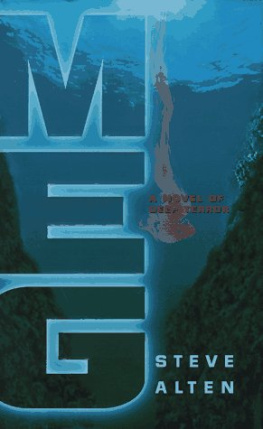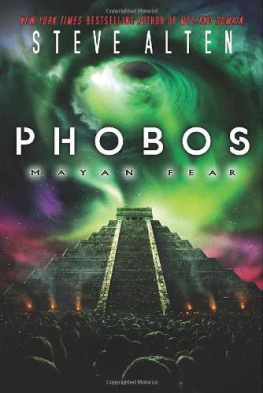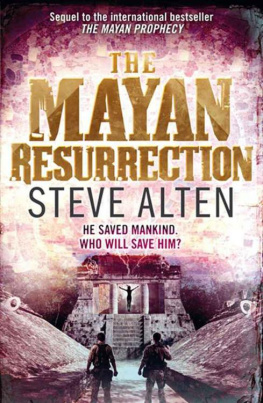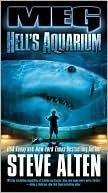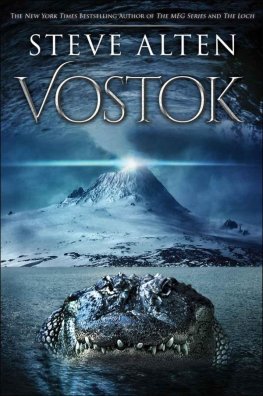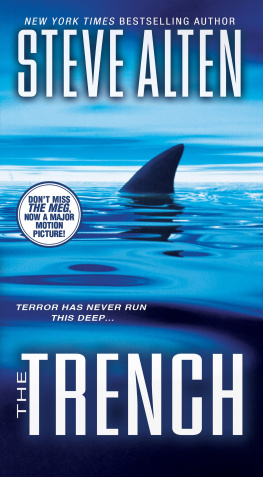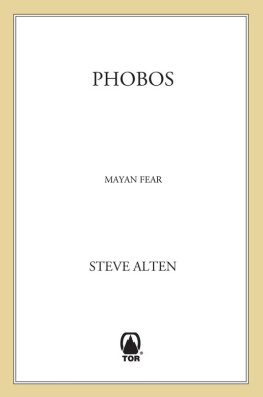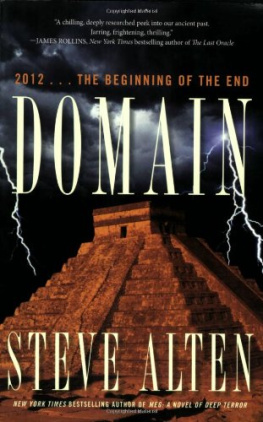Steve Alten - Meg: A Novel of Deep Terror
Here you can read online Steve Alten - Meg: A Novel of Deep Terror full text of the book (entire story) in english for free. Download pdf and epub, get meaning, cover and reviews about this ebook. year: 1998, publisher: Bantam Books, genre: Detective and thriller. Description of the work, (preface) as well as reviews are available. Best literature library LitArk.com created for fans of good reading and offers a wide selection of genres:
Romance novel
Science fiction
Adventure
Detective
Science
History
Home and family
Prose
Art
Politics
Computer
Non-fiction
Religion
Business
Children
Humor
Choose a favorite category and find really read worthwhile books. Enjoy immersion in the world of imagination, feel the emotions of the characters or learn something new for yourself, make an fascinating discovery.
- Book:Meg: A Novel of Deep Terror
- Author:
- Publisher:Bantam Books
- Genre:
- Year:1998
- Rating:3 / 5
- Favourites:Add to favourites
- Your mark:
- 60
- 1
- 2
- 3
- 4
- 5
Meg: A Novel of Deep Terror: summary, description and annotation
We offer to read an annotation, description, summary or preface (depends on what the author of the book "Meg: A Novel of Deep Terror" wrote himself). If you haven't found the necessary information about the book — write in the comments, we will try to find it.
Meg: A Novel of Deep Terror — read online for free the complete book (whole text) full work
Below is the text of the book, divided by pages. System saving the place of the last page read, allows you to conveniently read the book "Meg: A Novel of Deep Terror" online for free, without having to search again every time where you left off. Put a bookmark, and you can go to the page where you finished reading at any time.
Font size:
Interval:
Bookmark:

MEG
A Novel of Deep Terror
MEG 01
by
S t e v e A l t e n
MEGALODON
Late Cretaceous Period, 70 Million Years Ago
The Coast of the Asiamerica-Northern Landmass (Pacific Ocean)
From the moment the early morning fog had begun to lift, they sensed they were being watched. The herd of Shantungosaurus had been grazing along the misty shoreline all morning. Measuring more than forty feet from their duck-billed heads to the end of their tails, these reptiles, the largest of the hadrosaurs, gorged themselves on the abundant supply of kelp and seaweed that continued to wash up along the shoreline with the incoming tide. Every few moments, the hadrosaurs raised their heads nervously like a herd of deer, listening to the noises of the nearby forest. They watched the dark trees and thick vegetation for the movement, ready to run at the first sign of approach.
Across the beach, hidden among the tall trees and thick undergrowth, a pair of red reptilian eyes followed the herd. The Tyrannosaurus rex , largest and most lethal of all terrestrial carnivores, stood twenty-two feet above the forest floor. Saliva oozed from its mouth as T. rex watched, quivering with adrenaline. The two largest duckbills had just ventured out into shallow water, lowering their heads to forage among the thick strains of kelp.
The killer crashed from the trees, his eight tons pounding the sand and shaking the earth with every step. The duckbills rose on their hind legs and scattered in both directions along the beach. The two reptiles in the surf turned to see the carnivore closing on them, jaws wide, fangs bared, its bone-chilling roar drowning out the crash of the surf. The pair of hadrosaurs turned instinctively, plunging into deeper waters to escape. They strained their long necks forward and began to swim, their legs churning to keep their heads above water.
T. rex plunged in behind them, crashing through the surf and into deeper waters. But as it neared its prey, the T. rex 's feet sank into the muddy sea floor. Unlike the buoyant hadrosaurs, the thickly muscled T. rex could not swim and became hopelessly bogged in the mire.
The hadrosaurs now swam in thirty feet of water. But having escaped one predator, they now faced another.
The six-foot gray dorsal fin rose slowly from the sea, gliding silently across their path. The current created by the creature's sheer mass began pulling the hadrosaurs into deeper waters. The duckbills panicked at the sudden change. They would take their chances with the Tyrannosaurus . Within the deep waters lurked certain death. They turned, thrashing and paddling frantically until they once again felt the familiar mud beneath their feet.
T. rex let out a thundering growl. In water to its chest, the predator struggled to keep from sinking farther into the soft sea floor. The duck-bills broke in either direction, passing within fifteen yards of the frustrated hunter. The T. rex lunged at them, snapping its terrible jaws, howling in rage at its fleeing prey. The duckbills bounded through the smaller waves and staggered onto the beach. Collapsing on the warm sand, too exhausted to move, the two hadrosaurs looked back once more to face their would-be killer.
The Tyrannosaurus could now hold his huge head only a few feet above water. Insane with rage, it slashed its tail wildly in an attempt to free one of its hind legs. Then, all at once, it stopped struggling and stared out to sea. From the dark waters, slicing through the gray fog, the great dorsal fin was approaching.
The T. rex cocked its head and stood perfectly still, realizing too late that it had wandered into the domain of a superior hunter. For the first and last time in its life, the Tyrannosaurus felt the icy grip of fear.
If the T. rex was the most terrifying creature ever to walk the earth, then Carcharodon megalodon was easily lord and master of the sea. The red eyes of the Tyrannosaurus followed the gray dorsal fin, feeling the tug of current caused by the unseen mass circling below. The fin disappeared beneath the muddy waters. T. rex growled quietly, searching through the haze. The towering dorsal fin rose again from the mist, now racing directly for him. The T. rex roared and struggled, vainly snapping its jaws in futile protest.
From the beach, the two exhausted hadrosaurs watched as T. rex was slammed backward through the ocean with a great whoosh , its huge head disappearing beneath the waves. In a moment the dinosaur surfaced again, wailing in agony as its rib cage was crushed within the jaws of its hunter, a fountain of blood spouting from its mouth.
The mighty Tyrannosaurus rex vanished beneath the swirling scarlet water. A long moment passed, and the sea remained silent. The hadrosaurs turned and lumbered toward the trees. Suddenly they turned, cowering at an explosion in the water. Clutching T. rex in its gargantuan mouth, the sixty-foot shark, nearly three times the size of its prey, burst from the water, its enormous head and muscular upper torso quivering as it fought to remain suspended above the waves. Then, in an incredible display of raw power, the Meg shook the reptile from side to side between nine-inch serrated teeth, spraying pink froths and gouts of gore in every direction. The twenty-ton Megalodon and its mutilated prey crashed back into the sea, sending a great swell of water high into the air around them.
No other scavengers approached the Megalodon as it fed in the tropical waters. It had no mate to share its kill with, no young to feed. The Meg was a companionless creature, territorial by nature. It mated when it must and killed its young when it could, for the only challenge to its reign came from its own kind. It could adapt and survive the natural catastrophes and climatic changes that caused the mass extinctions of the giant reptiles and countless prehistoric mammals. And while its numbers would eventually dwindle, some members of its species might survive, isolated from the world of man, hunting in the isolated darkness of the ocean depths.
THE PROFESSOR
November 8, 1997 7:42 P.M.
The Scripps Institute, Anderson Auditorium
La Jolla, California
"Imagine a great white shark, fifty to sixty feet in length, weighing close to forty thousand pounds. Can you visualize that?" Professor Jonas Taylor looked at his audience of just over six hundred and paused for effect. "I find it hard to imagine myself sometimes, but this monster did exist. Its head alone was probably as large as a Dodge Ram pickup. Its jaws could have engulfed and swallowed four grown men whole. And I haven't even mentioned the teeth: razor-sharp, seven to nine inches long, with the serrated edges of a stainless steel steak knife."
The forty-two-year-old paleontologist knew he had his audience's attention. It had been several years since he had returned to the Institute. Lecturing in front of a nearly sold-out crowd was not something he had anticipated. Jonas knew his theories were controversial, that there were as many critics in the audience as there were supporters. He loosened his collar a little, tried to relax.
"Next slide, please? Ah, here we have an artist's rendition of a six-foot diver as compared with a sixteen-foot great white and our sixty-foot Carcharodon megalodon . I think this gives you a fairly good idea why scientists refer to the species as the king of all predators."
Jonas reached for the glass of water, took a sip. "Fossilized Megalodon teeth from around the world prove that the species dominated the oceans as long as seventy million years. What's really interesting is that we know that the Megalodon survived the cataclysmic events that occurred about sixty-five and forty-five million years ago, respectively, when the dinosaurs and most prehistoric species of fish perished. In fact, we have Megalodon teeth that indicate these predators disappeared only a hundred thousand years ago. From a geological standpoint, that's a tick of the clock."
Next pageFont size:
Interval:
Bookmark:
Similar books «Meg: A Novel of Deep Terror»
Look at similar books to Meg: A Novel of Deep Terror. We have selected literature similar in name and meaning in the hope of providing readers with more options to find new, interesting, not yet read works.
Discussion, reviews of the book Meg: A Novel of Deep Terror and just readers' own opinions. Leave your comments, write what you think about the work, its meaning or the main characters. Specify what exactly you liked and what you didn't like, and why you think so.

